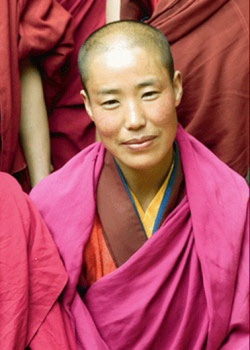Nuns and Buddhism's Decline?
Nuns and Buddhism's Decline?
By Indrajala (Jeffrey Kotyk)
As of late I have been reading through Dr. Jan Nattier's Once Upon a Future Time Studies in a Buddhist Prophecy of Decline, which is an excellent study surveying the multiple timetables found in Buddhist traditions for the decline of the dharma as well as the theories, stories and textual histories behind them.
One thing that really surprised me to learn was that the teaching given by the Buddha on how the dharma will only last five-hundred years, as opposed to one-thousand years, if women should be admitted into the community of renunciates is not found in all Nikāya canons. This means that not every early Buddhist school in India possessed this teaching in their collection of scriptures. The Pāli canon, utilized by the only extant Nikāya tradition today Theravāda, records the teaching as follows:
- "But, Ānanda, if women had not obtained the Going-forth from the home life into homelessness in the doctrine and discipline made known by the Tathāgata, the holy life would have lasted long, the true Dhamma would have lasted 1,000 years. But now that they have gotten to go forth... this holy life will not last long, the true Dhamma will last only 500 years. Just as a clan in which there are many women and few men is easily plundered by robbers and thieves, in the same way, in whatever doctrine and discipline women get to go forth, the holy life does not last long... Just as a man might make an embankment in advance around a great reservoir to keep the waters from overflowing, in the same way I have set forth in advance the eight rules of respect for bhikkhunīs that they are not to transgress as long as they live." — Cullavagga X.1
This teaching is found in the canons of the Sarvāstivādin, Mahīśāsaka, Dharmaguptaka, Theravādin and Haimavātas schools, all of which belong to the Sthaviravāda branch of early Buddhism. However it is not found in the known canon of any school belonging to the Mahāsāṃghika branch. This is significant because it may, as Jan Nattier points out, indicate that the story was added after the schism of the sangha which occurred at the “second second Buddhist council” in 340 BCE at Pāṭaliputra.[1] In other words, the idea of blaming nuns for the premature demise of the dharma was possibly introduced after the emergence of sectarian division within the sangha community. The Mahāsāṃghika Nikāya tradition did not have such a teaching as far as we know.
It is also interesting to note that in the Mahāsāṃghika's Śariputraparipṛcchā, which is the earliest extant account of the schism between the Mahāsāṃghika and Sthaviravāda, we hear of a council being convened at Pāṭaliputra over issues regarding the vinaya. The Mahāsāṃghika rejected proposals by the Sthaviravāda proponents to add rules to the vinaya (monastic regulations) and hence a schism occurred. It makes one wonder if this teaching concerning the introduction of nuns and the premature demise of the dharma was not a product of the Sthaviravādins who sought to introduce further rules.
So did the Buddha really teach that the dharma would decline prematurely due to the introduction of bhikṣuṇī (nuns) into the community? According to the Theravāda school this indeed is a canonical teaching and is accepted as such. However, as pointed out above questions arise when we consider why this teaching is absent from any extant Mahāsāṃghika canon we have available to us.
This is indeed an important issue that will need to be further discussed. In our modern day women are encouraged to sit with men on equal footing and rightfully demand their equality. The teaching cited above has and inevitably will prove to be problematic when discussions of women and Buddhism are brought up. It is also a point that can easily be attacked by critics of Buddhism. Whether or not one wants to accept this teaching, we can, at the very least, say it was and is a canonical teaching for only some Buddhists, but not necessarily all. The Pāli canon was not the only record of the Buddha Śākyamuni's teachings. Our present understanding of early Buddhism has generally been dictated by studies of the Pāli canon, but slowly scholars are looking at multiple branches to get a clearer look at the history of Buddhist thought. For a good overview of this take a look at the following article by Linda Heuman: Buddhism is Truest?
Footnotes
- ↑ See Nattier, Jan, Once Upon a Future Time Studies in a Buddhist Prophecy of Decline (Asian Humanities Press, 1991), 32.

